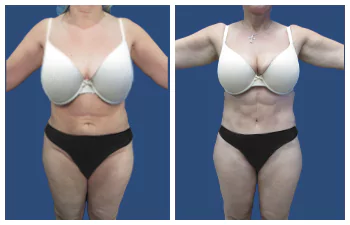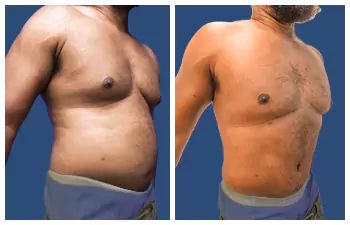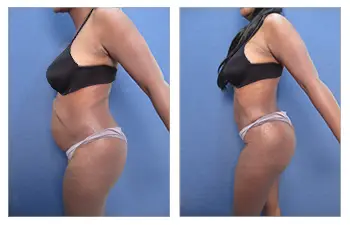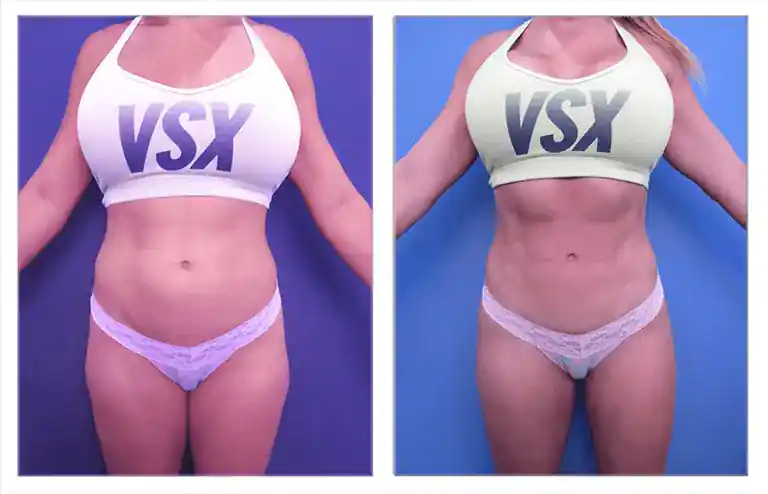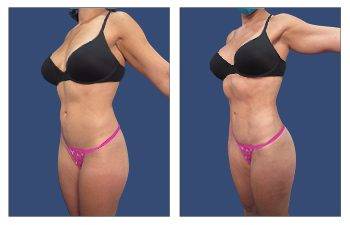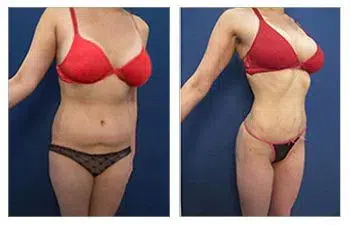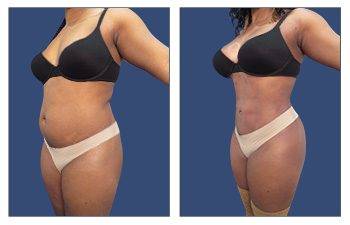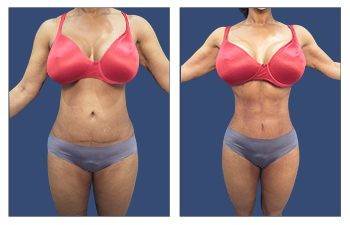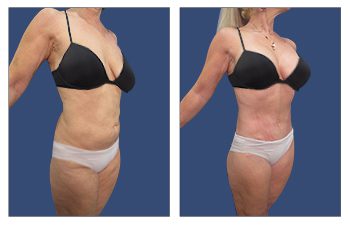How much does it cost to get lipo? It’s a question that plagues many considering this body contouring procedure. Liposuction, despite its popularity, is not always straightforward when it comes to pricing. The average liposuction cost can vary significantly based on numerous factors such as the type of procedure chosen, past medical history of the client, the expertise of your surgeon, and where you’re located geographically.
To truly understand how much liposuction costs, one must delve into specifics – from traditional methods to more advanced options like VASER Liposuction and complete a comprehensive medical evaluation. The first factor that must be considered in determining the average cost will include the number of treated areas. Treated areas may include the neck, upper/middle/lower abdomen, waistline, axilla, armpits, and flanks on the front side.
On the back side, areas of liposuction include the central upper back, called the buffalo hump, and the upper, middle, lower back, and flanks. For the limbs, areas of liposuction to be considered include the arms, lateral thighs, inner thighs, and knees. Cosmetic procedures involving multiple areas will result in higher fees because it takes longer to perform liposuction.
Another consideration includes the patient’s size, best characterized by body mass index calculated by an equation involving your height and weight. It should be intuitive that the larger areas of concern, the longer your surgery will take, thus the higher your operating room and anesthesia costs.
The next factor affecting the price includes the patient’s past medical history. There are factors in your history that will make your liposuction procedure more technical or require longer operative times. Liposuction prices will be affected by whether you have undergone prior liposuction, which results in scar tissue, making the liposuction procedure more difficult and time-consuming and causing higher operating room fees.
Excess fat laden with scar tissue is more difficult to remove and delineated as stubborn fat. Only higher-energy liposuction technologies such as VASER must often be implemented to remove fat. Other considerations that may alter the price of the liposuction performed include active medical conditions that will increase your risk of having surgery because of additional fees required to complete your liposuction surgery safely. The liposuction process often involves large volume shifts that require your body functions to be optimized and not strained by medical conditions.
The final consideration of liposuction risk includes the expertise and qualifications of your liposuction suction surgeon. For example, surgeons who are members of the American Society of Plastic Surgeons or the American Academy of Cosmetic Surgeons will have more training and experience than liposuction surgeons who are not surgically trained or are just starting.
The expertise of your surgeon may also affect whether he or she recommends traditional liposuction or more advanced liposuction techniques that include laser liposuction, PALS liposuction, or VASER liposuction, the gold standard of fat removal. In summary, performing liposuction is determined by several factors, including the scope of work, the technicality of your case, the cosmetic surgeon’s experience and skill, and the geographic location.
Geographic location considerations will affect operating room fees and general anesthesia fees charged by the anesthesiologists. Please continue reading this blog to appreciate how much it costs to get liposuction.
How Much Does Liposuction Cost?
Unraveling the cost of traditional liposuction requires understanding various factors that come into play. The treatment area is a crucial determinant, with each body part having a unique price range due to the varying expertise and time required by surgeons.
To illustrate, smaller regions like the chin or neck may cost less than larger areas such as the abdomen or thighs. This disparity stems from the complexity involved in treating different specific regions.
Liposuction Cost: Key Determinants
The total expenditure on liposuction hinges significantly on how much fat needs to be removed. Surgeons often bill based on this volume because removing more fat means longer operation times and increased effort.
Beyond this, other surgery-related costs like anesthesia fees, hospital charges, medical tests, and post-surgery garments contribute to the final billable amount. A comprehensive understanding of these components can aid in accurately estimating your expected expenditure for a traditional liposuction procedure.
Average Price Range: An Overview
The American Society of Plastic Surgeons states that an average surgeon’s fee for single-session lipoplasty was around $ 3,500 back in 2018; however, note that it doesn’t account for ancillary costs related directly or indirectly to performing this operation successfully.
According to the American Society for Aesthetic Plastic Surgery (ASAPS), expenses incurred during a typical suction-assisted lipectomy ranged anywhere between $2000 – $8000 at that time, but healthcare inflation over the years might have caused an increase now.
It’s evident that investing financially into cosmetic surgeries isn’t insignificant; hence, potential patients should consider every angle before deciding about undergoing procedures under the knife.
Exploring further into the intricate realm of traditional liposuction reveals more to be discovered.
VASER Liposuction Cost
When considering VASER liposuction, it’s essential to understand that its cost is typically higher than traditional liposuction. This advanced procedure uses ultrasonic waves to break down fat cells, leading to more precise and effective results.
The overall expense of this innovative method can range from $3,000 up to $10,000 or even more. It’s crucial to consider the quoted price and factor in additional costs like anesthesia fees and post-surgery care, which may not be included initially.
Understanding Factors That Influence VASER Liposuction Cost
Navigating through your cosmetic surgery journey involves understanding various factors that influence the final cost of your treatment. One significant element is the extent of areas you want to be treated – whether targeting one specific area or multiple regions will undoubtedly impact total expenses. For instance, the American Society of Plastic Surgeons indicates that larger areas, such as the abdomen or thighs, generally carry a heftier price tag than smaller zones like the chin or neck.
Your chosen plastic surgeon’s expertise level and reputation within their field are other critical pricing components. As with many services, highly skilled surgeons with extensive training often charge higher rates due to their demonstrated success in delivering excellent outcomes.
Planning Your Budget For The Procedure
Facing cosmetic surgery expenses might seem overwhelming initially; however, options are designed specifically for this purpose. Although CareCredit offers financing plans tailored for medical bill payments over time without any required upfront payments, we do not offer this service here at SurgiSculpt.
It’s vital, though, when budgeting, not to focus solely on surgical costs but to consider extra charges, too, such as pre-operative tests, aftercare medications, and follow-up visits necessary for ensuring a successful recovery process.
Before you dive in, getting some pro advice on the money side of things is smart. This lets you decide wisely whether this medical expenditure fits your financial plan.
Anesthesia General Cost
When looking at liposuction, the cost of anesthesia is an essential element to factor into your budget. The total cost can vary widely depending on the type and duration of anesthesia required for your procedure.
Understanding Anesthesia Types and Associated Costs
Different types of anesthesia are used during liposuction procedures, each with its price tag. Local anesthesia, which numbs only a specific area, generally incurs lower costs than general or regional anesthesia.
General anesthesia involves being placed into controlled unconsciousness, typically costing between $600 and $1,000 per hour. On the other hand, regional anesthesia blocks pain in larger body sections while keeping you awake, and this usually costs patients around $500 to $800 per hour.
The Impact of Procedure Duration on Anesthesia Cost
The expected duration of your liposuction surgery directly affects the cost of anesthesia. If multiple areas need attention or if significant fat deposits require removal, resulting in longer operation timeframes, you should expect higher overall sedation charges.
You may come across online resources offering pricing guidelines, but remember that these should be used as broad estimates since individual circumstances greatly influence the final costs. For comprehensive information on the factors contributing to calculating surgical expenses, including those associated with anesthesia, you can visit The American Society of Plastic Surgeons.
Now that we’ve explored the cost dynamics related to general anesthesia methods used in liposuction let’s shift our focus to another potential avenue that promises significant savings: awake liposuction.
Demystifying the Cost of Liposuction: How Much Does it Cost?
There is a growing interest in awake liposuction in cosmetic plastic surgery. But what about the cost? Compared to traditional methods requiring a full anesthetic team and monitoring equipment, awake liposuction is a more cost-effective option.
“Awake liposuction presents patients with an affordable body contouring solution due to reduced anesthesia-related costs.”
In addition to cost-savings, awake liposuction offers quicker healing times and decreased post-procedure discomfort.
The Financial Appeal of Awake Liposuction
One of the main reasons why many people consider awake liposuction is its affordability. The absence of general anesthesia significantly reduces associated expenses, making it an attractive option for those on a budget.
- There is no need for extensive monitoring devices or anesthesiology staff, which significantly cuts down operational costs.
- Shorter operation time means fewer charges related to clinic usage and professional fees.
- Potential savings on post-operative care as recovery from local anesthesia tends to be quicker than general anesthesia.
Navigating Through Variables Affecting Liposuction Costs
However, when evaluating the total cost of liposuction, several factors come into play:
| Factor | Description |
|---|---|
| Your geographical location: | Different regions have varied living standards that influence healthcare pricing. |
| Surgical complexity & duration: | More complex procedures that take longer can result in higher costs. |
| Surgeon’s expertise: | Experienced professionals may charge more, but their proficiency ensures safety during your operation. |
So, even though awake liposuction might look like a cheaper option initially, it’s not always the case.
Additional Costs
Liposuction is a significant investment, and understanding the full cost means considering not just the surgery itself but also additional costs that can arise. These often include pre-operative tests, post-operative care, medications, and garments.
Pre-Operative Tests
Before liposuction surgery, various medical examinations are usually required to ensure patient safety. Depending on individual health status and history, these may range from blood work to imaging studies like ultrasounds or MRI scans.
The expenses for these preliminary evaluations vary based on their complexity and number. Importantly, insurance does not typically cover such costs when linked with cosmetic procedures.
Post-Operative Care
Beyond the initial surgical fees for liposuction lies another crucial aspect of budgeting: aftercare services. Regular check-ups following your operation are essential in monitoring recovery progress while minimizing the potential risk of complications.
This includes routine visits with your surgeon and any necessary physical therapy sessions if extensive liposuction treatment areas temporarily affect mobility.
Mandatory Medications
A key component of successful recovery from any surgical procedure involves adhering strictly to prescribed medication regimens. Pain relievers manage discomfort during healing, whereas antibiotics mitigate infection risks at incision sites caused by bacterial exposure post-surgery. It’s important to remember that medication prices fluctuate greatly depending on the type prescribed and whether generic versions are available cheaper than branded counterparts.
Surgical Garments
An often overlooked yet vital part of the total liposuction expenditure relates directly to specialized garments designed to aid the healing phase. Wearing compression clothing following this procedure helps reduce swelling and improve skin retraction, contributing to a better final result from an aesthetic standpoint. This is ultimately what most patients desire when undergoing plastic surgery. Therefore, don’t forget to factor in purchasing a couple of pieces of equipment when budgeting for the whole procedure from start to finish.
Now that we have understood how much you might end up spending besides the basic package price tag attached to each case let’s move on to discussing possible ways of
Exploring Financing Options for Liposuction
The cost of liposuction can be a significant investment, but fortunately, there are several financing options to consider if paying the full amount upfront is not feasible.
Dive into Personal Loans
One avenue you might want to explore is personal loans. Traditional banks or online lenders could offer viable solutions. Remember that terms and interest rates vary widely among these institutions; therefore, comparing different loan offers is critical.
Leverage Your Credit Cards
If your credit card has a sufficient limit, it could be another way to finance your procedure. Some cards provide introductory periods with low or even zero interest rates, making this option attractive if managed properly within the promotional period. CreditCards.com provides comprehensive information on such deals.
Navigate Surgical Financing Companies
An alternative specifically tailored for medical procedures like liposuction is surgical financing companies. These firms often offer competitive interest rates and flexible repayment plans designed to fit comfortably within your budget constraints.
Ponder Over In-house Financing Plans
In addition, some cosmetic surgery clinics offer their in-house financing schemes (American Society of Plastic Surgeons). This means they will work directly with you to create a payment plan perfectly suited for your financial situation without any third-party involvement.
Regardless of the method chosen for funding your procedure, ensure thorough research into all potential costs involved, including consultation fees, surgeon’s fees, anesthesia charges, etc., alongside the actual cost of the procedure itself. When dealing with finances, hidden surprises are never welcome.
<.– next section>
Insurance Coverage
Because liposuction is seen as a discretionary aesthetic procedure, insurance firms tend not to provide coverage. But this can change.
Understanding Insurance Coverage for Liposuction
The topic of insurance coverage often arises when discussing the cost of liposuction. While it is generally perceived that most insurance providers do not cover cosmetic procedures like liposuction, there are exceptions and nuances worth exploring.
Determining Your Insurance Policy’s Stance on Liposuction
Prior to deciding on liposuction, it is wise to contact your insurance company directly. You should ask specific questions about what aspects of the procedure would be covered under your policy and how much they might contribute towards its total cost.
In addition, you may want to discuss pre-approval requirements or restrictions concerning where the surgery can take place. Some policies have stipulations regarding certain facilities or surgeons only.
Possible Exceptions in Policies Regarding Liposuctions
Certain medical conditions caused by excess body fat could potentially warrant therapeutic liposuction, which some health insurance might cover as an exception. Conditions such as lymphedema or skin infections resistant to other treatments could fall into this category.
Navigating Out-of-Pocket Costs
If you find out that your insurer does not provide coverage for cosmetic plastic surgeries like liposuction, don’t worry. There are various alternative financing options available. These include personal savings accounts (PSAs) and low-interest-rate credit cards designed specifically for healthcare expenses.
Additionally, loans from financial institutions specializing in medical financing can also be explored. Understanding these alternatives will help manage out-of-pocket costs effectively while achieving desired aesthetic results without compromising financial stability.
Ensuring Informed Decisions
Before committing to liposuction, it is critical to be well-informed by researching costs, verifying coverage with your insurer, and exploring payment options. This includes researching potential expenditures, checking with your insurer before scheduling anything, and looking into various funding possibilities. Gathering pertinent data is critical in coming to an educated conclusion.
Check out more details here.
FAQs in Relation to How Much Does Liposuction Cost?
How much does liposuction cost?
Uncover what determines liposuction cost, from the type of procedure to insurance factors. Get informed about your investment in body contouring.
How much does liposuction cost for your stomach?
The price of abdominal liposuction can range from $2,000 to $7,500. This fluctuation is due to the complexity and size of the treated area.
How much weight can you lose with liposuction?
Liposuction isn’t a weight loss procedure but rather a body contouring. You may shed up to 11 pounds of fat. However, it varies based on individual factors.
Is liposuction worth the money?
If achieving a desired body shape boosts your confidence and well-being, investing in liposuction could be worthwhile for you.
How long does lipo last?
Liposuction results are typically permanent if you maintain a stable weight post-procedure. A healthy lifestyle will ensure the longevity of results.
Conclusion
- You’ve now explored the realm of lipo and its associated pricing.
- You now understand that traditional liposuction costs are influenced by factors such as the treatment area and the amount of fat removed.
- The higher cost of VASER Liposuction is justified due to its advanced technology and precision capabilities.
- The choice between general anesthesia or awake options can also impact the final bill.
- Other expenses are also to consider, including pre-operative tests, post-op care, medications, and even garments.
- Fortunately, many patients can access financing options that make this body transformation journey more affordable.
- Your insurance coverage may also play a role, so it’s worth checking with your provider before proceeding with any procedure.
If enhancing your physique through cosmetic plastic surgery seems like the right move for you, don’t let the cost of liposuction hold you back!
SurgiSculpt, an expert in body contouring procedures, is here to guide you every step of the way on this transformative journey. Visit our website today for further information about making an informed investment in yourself.



